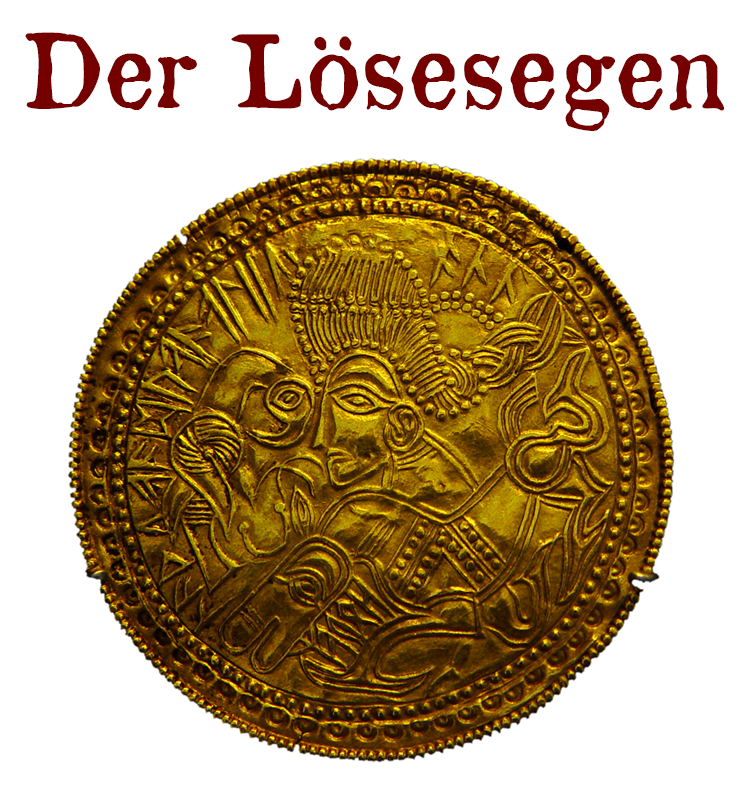Der Lösesegen
- At March 02, 2019
- By Great Quail
- In Deadlands, Relics
 0
0
Description
Arcane Item; Restrictions: None
A medieval talisman known as a “bracteate,” this thin disc of bronze is meant to be sewn into clothing or worn as an amulet. It depicts three warrior-goddesses releasing a Germanic knight from bondage. Wearing fantastical armor and glowing with vigor, these warriors are “idisi”—female guardian spirits related to valkyries and Norns. The back of the bracteate features a series of magical symbols, mostly runes, swastikas, and triskelions. The following lines of Old High German are inscribed on the front of the bracteate: “Eiris sazun idisi.” Written upon the reverse are the lines: “Insprinc haptbandun, inuar uigandun.”
The inscriptions represent the first and last lines of a medieval incantation: “Eiris sazun idisi, sazun hera duoder; suma hapt heptidun, suma heri lezidun, suma clubodun umbi cuoniouuidi: insprinc haptbandun, inuar uigandun.” It may be translated as, “Once sat idisi, they sat here; then there. Some fastened bonds, some impeded an army, some unraveled fetters: Escape the bonds, flee the enemy!”
Powers
The bracteate is a Lösesegen, or “releasing charm,” and is derived from the Merseburger Zaubersprüche, a page of pagan incantations dating from the ninth century. If the Lösesegen (pronounced roughly as LOWR-zuh-zay-gin) is carried by a person placed in non-magical bondage, it grants him a Spirit roll to escape imprisonment. If the roll is successful, escape is achieved through “incidental” methods. Perhaps the jailor dropped his key, the handcuffs have a faulty link, or the oubliette contains a secret door. A raise on the Sprit roll secures an immediate and more dramatic escape. Perhaps the jailor taunts the subject a little too closely, or the cavalry comes charging over the hill. A Critical Success, however, summons forth one of the idisi from legend. Shimmering with unearthly power, the goddess liberates the prisoner and punishes his enemies, presumably with her spear and magic helmet!
Limitations
A Lösesegen may be used multiple times, but upon a Critical Failure or a Critical Success, its power is forever drained.
Replicas
Being a priceless medieval artifact, there are few authentic Lösesegensin circulation. It is considerably more likely that a Deadlands character will possess a nineteenth-century replica. Such replicas experienced a brief vogue after the Merseburger Zaubersprüche were discovered by German historian Georg Waitz in 1841, and published in translation by Jakob and Wilhelm Grimm the following year. A contemporary Lösesegenis likely to be smaller, fashioned out of copper, and equipped with a clasp, hole, or some other way to attach a thong. If produced by an artisan with an Arcane Background, a replica may possess the same powers as the medieval original; however, a replica is permanently drained by a single successful use.
Sources & Notes
The origins of the Lösesegenare outlined on the “Merseburg Charms” Wikipedia page, and were made popular by the Brothers Grimm, who published a modern translation in Über zwei entdeckte Gedichte aus der Zeit des deutschen Heidenthums (“Two Newly-Discovered Poems from the German Heroic Period”). And, if you’d like to hear these pagan incantations whispered dramatically over New Age music while half-naked German valkyries alternate with photographs of the Society for Creative Anachronism staging Wagner, you’re in luck! Also, the fourth album by the German neofolk group “Schwartzblut” is called Idisi, and has a track based on the Lösesegen.
Image Credits
The bracteate used to illustrate this page is actually Danish in origin, but if you squint hard and use your imagination, you can see the idisi releasing an imprisoned knight. Or, maybe not; but you get the general idea from Emil Doepler’s wonderful 1905 illustration. Keep in mind, despite the expressions of longing on their faces, these gentlemen are being untied.
Author: A. Buell Ruch
Last Modified: 2 March 2019
Email: quail (at) shipwrecklibrary (dot) com
PDF Version: [Coming Soon]


